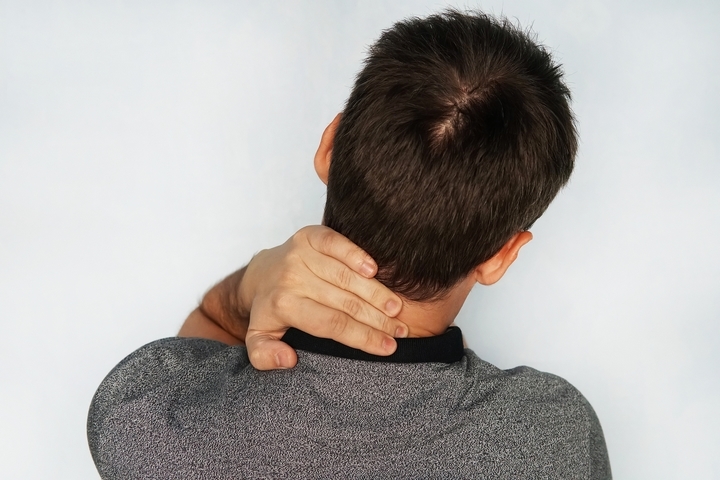Our neck has an important job to do. It supports the weight of our head, allowing for movement and is the bridge between our skull and torso. It protects the path of motor, sensory information and nutrients throughout the body with a complex network of muscles, nerves, connective tissue, bones, blood vessels and lymphatics working in harmony under the tough conditions of life.
We all have experienced neck pain, and it varies from a dull ache to stabbing pain. If you have consistent pain over three months, it is considered chronic. Chronic neck pain is best treated at a physiotherapy clinic through regular treatments. The physiotherapy will inspect your condition and prescribe a treatment plan customized for you.
How do we experience this condition? Here are some chronic neck pain causes we may encounter:
Cause #1: Traumatic Injury

Accidents happen, and injuries could be severe enough for the pain to persist. Chronic neck pain may result from a workplace accident where you have tripped, slipped or suffered a fall. Sports injuries are also a common cause of neck injuries where the pain persists.
Car accidents are often an incident where the neck is affected because a sudden stop jolts your head and neck muscles, resulting in whiplash. Any sudden impact that affects your neck may become chronic, and you should see your doctor check it out.
Cause #2: Herniated Disc

The cervical spine is a row of 7 vertebrae in your neck, connecting the skull to the back, and they all have discs between them to absorb shock and distribute the load. Discs have a strong, fibrous outer layer with a gel-like inner layer that can get torn, allowing the gel to poke out. When this compresses on a nerve, you get pain.
A herniated disc can happen for several reasons, including wear and tear from aging, sudden jarring movements, strains and even genetics. The result is chronic pain in the neck that can also radiate into the shoulder and down the arm to the hands.
Cause #3: Cervical Spondylosis

Cervical Spondylosis is a term for age-related spinal degeneration in the neck that happens over time but can be accelerated with an injury. It is commonly called arthritis of the neck, and 85% of people over 60 experience it. This condition includes:
- Cervical Osteoarthritis The bones start grinding together because the cartilage on the facet joint wears away. Bone spurs may develop as a result.
- Cervical Central Stenosous A narrowing of the spinal canal in the neck, compressing the spinal cord.
- Cervical Foraminal Stenosis A narrowing of the intervertebral foramen, compressing the cervical nerve root.
- Cervical Degenerative Disc Disease Discs lose height, hydration and flexibility, compressing nearby nerves.
Cause #4: Fibromyalgia

Fibromyalgia is hard to diagnose but presents as musculoskeletal pain, fatigue and tender points in the back and neck. Painful attacks can come and go and affect mood, sleeping patterns and even sleep. This increased sense of pain is called Hyperalgesia. While scientists do not fully understand the condition, it is believed that pain signals are more amplified in the brain and spinal cord in those with fibromyalgia.
It can develop over time without triggering, or physical trauma can start symptoms. Medication, physical therapy and massage may help ease the pain.
Cause #5: Posture

Poor posture can cause chronic neck pain if you regularly tilt your head in a forward head posture. Your head should sit in a neutral position with chest open, shoulders back and your ears directly over your shoulders. This is an optimal position that won’t strain the muscles in the neck.
We live in a digital age where we work over a computer and stare at our smartphones for hours every day. This slouching posture puts stress on our muscles, discs and joints in the cervical spine, leading to chronic pain and aggravating other conditions like cervical osteoarthritis or degenerative disc disease.
The sensation you feel from chronic neck pain can vary in intensity as time goes on and may ebb and flow without apparent cause. Usually, neck pain is classified as follows:
- Axial Pain This pain is the most common type and will affect one region of the neck. It can be dull, throbbing, stinging or sharp and worsens with certain movements. Strains and sprains are usually the cause, but trauma and degeneration are also related.
- Radicular Pain Radicular pain is an inflamed nerve root in the cervical spine that can radiate along the nerve. It may head down the arm to the hand and feel intense but only on one side of the body.
- Referred Pain You may experience pain in a different location from the source, and it will be throbbing or cramping. While a trigger point in the neck is compressed, the pain is referred to the shoulder, upper back or head.
- Myelopathic Pain is a spinal cord compression that causes compression and the extremities like the legs and feet. Numbness and tingling occur, and you can have balance problems and clumsiness.
Nobody wants to experience pain, especially in their neck. This area is a gateway to the body, so protecting it is vital. Understanding chronic neck pain causes will empower you to avoid activities that may trigger it. Go gently out into the world and take good care of your neck.
